The Transilluminators Market is estimated to be valued at USD 117.9 million in 2025 and is projected to reach USD 192.1 million by 2035, registering a compound annual growth rate (CAGR) of 5.0% over the forecast period.
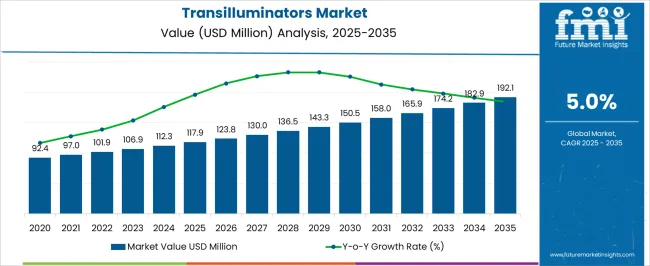
| Metric | Value |
|---|---|
| Transilluminators Market Estimated Value in (2025 E) | USD 117.9 million |
| Transilluminators Market Forecast Value in (2035 F) | USD 192.1 million |
| Forecast CAGR (2025 to 2035) | 5.0% |
The Transilluminators market is experiencing robust growth driven by the increasing adoption of molecular biology and microbiology techniques in educational and research institutions. The current scenario reflects a growing demand for advanced laboratory equipment that enables visualization of nucleic acids, proteins, and other biomolecules. In 2025, the market is primarily fueled by investments in academic infrastructure, expanding laboratory curricula, and rising awareness about practical laboratory training.
The evolution of compact, energy-efficient, and software-assisted transilluminators has further enhanced their usability and appeal in educational settings. With an increasing number of institutions integrating hands-on molecular biology programs and microbiology experiments, the demand for transilluminators capable of delivering accurate and reproducible results has surged.
Additionally, improvements in safety features, LED-based illumination, and compatibility with various gel types are shaping the future outlook of the market As educational institutions continue to modernize laboratories and emphasize experiential learning, the Transilluminators market is anticipated to maintain sustained growth, offering scalable and reliable solutions for academic and research purposes.
The transilluminators market is segmented by end use, application, and geographic regions. By end use, transilluminators market is divided into Educational Institutions and Research & Development Laboratories. In terms of application, transilluminators market is classified into Microbiology, Biochemical, Pharmaceutical, and Others. Regionally, the transilluminators industry is classified into North America, Latin America, Western Europe, Eastern Europe, Balkan & Baltic Countries, Russia & Belarus, Central Asia, East Asia, South Asia & Pacific, and the Middle East & Africa.
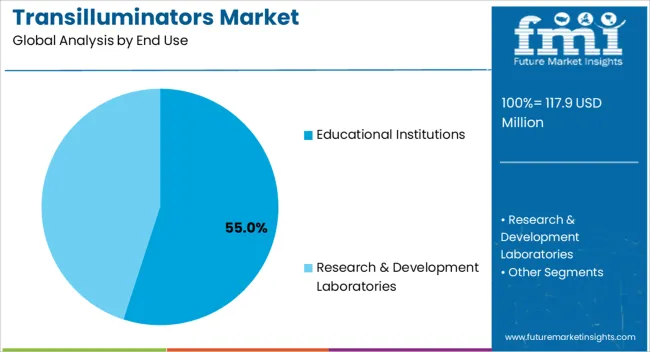
The Educational Institutions end-use segment is expected to account for 55.0% of the Transilluminators market revenue in 2025, making it the largest segment. This dominance is being attributed to the growing emphasis on practical laboratory training across undergraduate and postgraduate programs in molecular biology and microbiology.
Adoption has been accelerated by the need for equipment that allows students to visualize DNA and protein gels safely and efficiently, while accommodating high-throughput laboratory sessions. The popularity of this segment is further supported by the cost-effectiveness, durability, and ease of operation offered by modern transilluminators, which allow multiple students to work simultaneously without compromising experimental accuracy.
With the increasing integration of technology-enhanced learning and virtual lab simulations complementing hands-on training, the demand for reliable and adaptable transilluminators has expanded The growth of this segment is expected to continue as educational institutions prioritize curriculum modernization, safety, and reproducible experimental outcomes, reinforcing the segment’s leadership in the market.
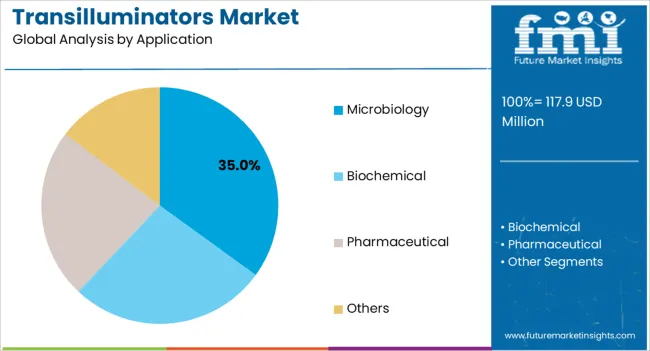
The Microbiology application segment is projected to hold 35.0% of the Transilluminators market revenue in 2025, establishing it as the leading application area. This leadership has been driven by the widespread use of transilluminators in microbiology laboratories for visualization of bacterial DNA, plasmids, and other biomolecular assays.
Adoption has been supported by the enhanced sensitivity and resolution of modern devices, which facilitate precise experimental observations and reliable data collection. The segment’s growth has also been influenced by the increasing focus on research in microbial genetics, antibiotic resistance studies, and biotechnology applications within academic and commercial laboratories.
Additionally, the integration of LED-based illumination systems and compatibility with multiple gel types has improved usability and safety, further driving adoption As research in microbiology continues to expand globally, the demand for advanced transilluminators capable of providing clear visualization and reproducible results is expected to sustain the growth of this segment, solidifying its prominent position in the market.
Ultraviolet transilluminators facilitate the optimum visibility of various electrophoresis gels, such as polyacrylamide and agarose gels. They help visualise the targeted deoxyribonucleic acids and proteins in study samples and specimens under a microscope.
Ultraviolet transilluminators work by emitting high-intensity ultraviolet radiation that passes through the viewing surface. Transilluminators are most frequently used in life science laboratories that are focused on microbiological research and development. Currently, manufacturers are offering stainless steel filter framed transilluminators that are scratch-proof and chemical resistant.
These upgraded solutions are targeted towards the biochemical industry.
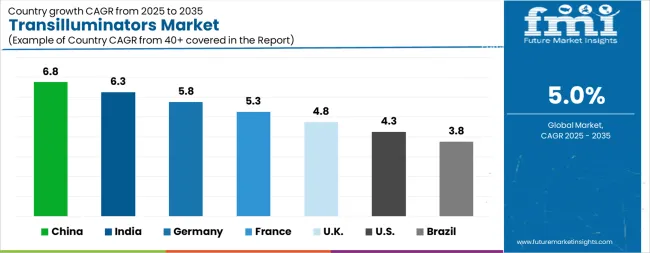
| Country | CAGR |
|---|---|
| China | 6.8% |
| India | 6.3% |
| Germany | 5.8% |
| France | 5.3% |
| UK | 4.8% |
| USA | 4.3% |
| Brazil | 3.8% |
The Transilluminators Market is expected to register a CAGR of 5.0% during the forecast period, exhibiting varied country level momentum. China leads with the highest CAGR of 6.8%, followed by India at 6.3%. Developed markets such as Germany, France, and the UK continue to expand steadily, while the USA is likely to grow at consistent rates. Brazil posts the lowest CAGR at 3.8%, yet still underscores a broadly positive trajectory for the global Transilluminators Market. In 2024, Germany held a dominant revenue in the Western Europe market and is expected to grow with a CAGR of 5.8%. The USA Transilluminators Market is estimated to be valued at USD 42.3 million in 2025 and is anticipated to reach a valuation of USD 64.1 million by 2035. Sales are projected to rise at a CAGR of 4.3% over the forecast period between 2025 and 2035. While Japan and South Korea markets are estimated to be valued at USD 6.1 million and USD 3.2 million respectively in 2025.
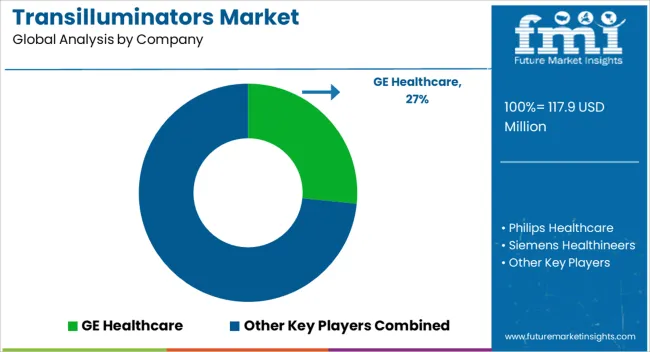
| Item | Value |
|---|---|
| Quantitative Units | USD 117.9 Million |
| End Use | Educational Institutions and Research & Development Laboratories |
| Application | Microbiology, Biochemical, Pharmaceutical, and Others |
| Regions Covered | North America, Europe, Asia-Pacific, Latin America, Middle East & Africa |
| Country Covered | United States, Canada, Germany, France, United Kingdom, China, Japan, India, Brazil, South Africa |
| Key Companies Profiled | GE Healthcare, Philips Healthcare, Siemens Healthineers, Baxter International Inc., Hill-Rom Holdings, Inc., Veinlite, Advin Health Care, TransLite LLC, Lutech Industries, and Venoscope LLC |
The global transilluminators market is estimated to be valued at USD 117.9 million in 2025.
The market size for the transilluminators market is projected to reach USD 192.1 million by 2035.
The transilluminators market is expected to grow at a 5.0% CAGR between 2025 and 2035.
The key product types in transilluminators market are educational institutions and research & development laboratories.
In terms of application, microbiology segment to command 35.0% share in the transilluminators market in 2025.






Our Research Products

The "Full Research Suite" delivers actionable market intel, deep dives on markets or technologies, so clients act faster, cut risk, and unlock growth.

The Leaderboard benchmarks and ranks top vendors, classifying them as Established Leaders, Leading Challengers, or Disruptors & Challengers.

Locates where complements amplify value and substitutes erode it, forecasting net impact by horizon

We deliver granular, decision-grade intel: market sizing, 5-year forecasts, pricing, adoption, usage, revenue, and operational KPIs—plus competitor tracking, regulation, and value chains—across 60 countries broadly.

Spot the shifts before they hit your P&L. We track inflection points, adoption curves, pricing moves, and ecosystem plays to show where demand is heading, why it is changing, and what to do next across high-growth markets and disruptive tech

Real-time reads of user behavior. We track shifting priorities, perceptions of today’s and next-gen services, and provider experience, then pace how fast tech moves from trial to adoption, blending buyer, consumer, and channel inputs with social signals (#WhySwitch, #UX).

Partner with our analyst team to build a custom report designed around your business priorities. From analysing market trends to assessing competitors or crafting bespoke datasets, we tailor insights to your needs.
Supplier Intelligence
Discovery & Profiling
Capacity & Footprint
Performance & Risk
Compliance & Governance
Commercial Readiness
Who Supplies Whom
Scorecards & Shortlists
Playbooks & Docs
Category Intelligence
Definition & Scope
Demand & Use Cases
Cost Drivers
Market Structure
Supply Chain Map
Trade & Policy
Operating Norms
Deliverables
Buyer Intelligence
Account Basics
Spend & Scope
Procurement Model
Vendor Requirements
Terms & Policies
Entry Strategy
Pain Points & Triggers
Outputs
Pricing Analysis
Benchmarks
Trends
Should-Cost
Indexation
Landed Cost
Commercial Terms
Deliverables
Brand Analysis
Positioning & Value Prop
Share & Presence
Customer Evidence
Go-to-Market
Digital & Reputation
Compliance & Trust
KPIs & Gaps
Outputs
Full Research Suite comprises of:
Market outlook & trends analysis
Interviews & case studies
Strategic recommendations
Vendor profiles & capabilities analysis
5-year forecasts
8 regions and 60+ country-level data splits
Market segment data splits
12 months of continuous data updates
DELIVERED AS:
PDF EXCEL ONLINE

Thank you!
You will receive an email from our Business Development Manager. Please be sure to check your SPAM/JUNK folder too.
Chat With
MaRIA